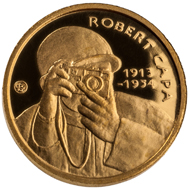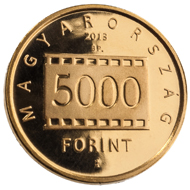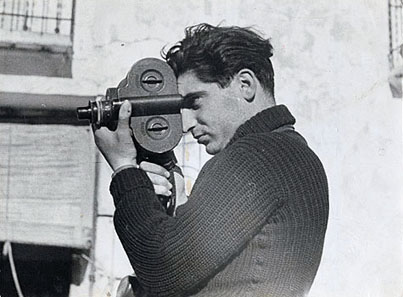October 31, 2013 – On the occasion of his 100th anniversary, the Central Bank of Hungary issues a commemorative coin in honor of Robert Capa, one of the most important photographers of the 20th century, working primarily as a photojournalist and war correspondent.
Hungary / 5,000 HUF / Au .999 / 0.5 g / 11 mm / Designer: Antal Illyés (obv) and György Szabó (rev) / Mintage: 5,000.
This coin is the fourth piece in the collector series “The World’s Smallest Gold Coins”, issued by the Central Bank of Hungary.
Photographer Robert Capa was born on October 22, 1913 in Budapest, as Endre Friedmann. He was one of the most important photographers of the 20th century, working primarily as a photojournalist and war correspondent. A famous quote of Capa runs as follows: “If your photographs aren’t good enough, you aren’t close enough.”
Photographer Robert Capa during the Spanish civil war, May 1937. Photo by Gerda Taro. Source: Wikipedia.
Capa’s parents ran a tailor shop, raising three boys. His younger brother also became a famous photographer using the name Cornell Capa. Endre Friedmann completed his secondary schooling at the Madách Gimnázium in Budapest, and participated in ‘Work Circle’ events associated with the writer Lajos Kassák.
He moved to Berlin in 1931, where he studied journalism at the German Political College, while also working as a laboratory assistant at the Dephot news agency. His first famous picture was a shot of Trotsky published in the periodical Weltspiegel. After Hitler came to power, he left Berlin for Paris, where he continued working as a photographer under the name André Friedmann. His received his first assignment from the magazine Vu in 1934 and started using the name Robert Capa from 1936. There are two widespread theories for the origin of this name: among his Hungarian friends his nickname was “cápa” (shark) and according to one version this was the basis for his choice. The other version is that he was hoping for more work as a photographer, as the name “Capa” in American sounded like the name of the popular film director Frank Capra. He arrived in Spain in 1936 using this name and spent several years covering the Spanish civil war. One of his most famous pictures comes from this period, the “Falling Soldier”.
He shot a series on the events of the 1938 Sino-Japanese war, spending a half year in China. He was a photographer during the Second World War in the North African and Italian campaigns, and participated in the invasion of France (Normandy). His series of photographs of the D-Day landing, known as The Magnificent Eleven, became world famous. These pictures later inspired the opening scenes of Steven Spielberg’s film, Saving Private Ryan. He became a US citizen in 1946, and received the Medal of Freedom for his wartime work. With his photographer friends, he founded the photo agency Magnum Photos in 1947, of which he became president.
In 1948, he photographed the battles which erupted when the state of Israel was proclaimed. On two other trips to Israel he photographed arriving Jewish settlers. During the 1950s he mostly lived in Paris. He was working in Japan in 1954, when he accepted an assignment from Life magazine to cover the fighting in the French colony of Indochina. On May 25th, he was accompanying a French convoy near the Red River delta when he stepped on a landmine near Thai Binh and was killed almost immediately.
In 1964, his brother Cornell Capa established a foundation in New York to administer his legacy. This later became the International Center of Photography, which currently operates as an archive, gallery and school of photography.
If you want to learn more about the Hungarian Mint, please click here.
This little movie with shots by Robert Capa shows the Allied Forces’ landing in the Normandy.
A portrait of Capa can be found in this YouToube film.
If you prefer reading you might want to look at Wikipedia first and check out the interesting links as well.
And this is the website of the International Center of Photography.







